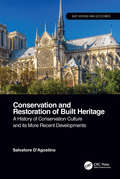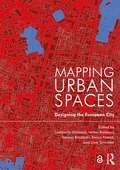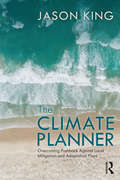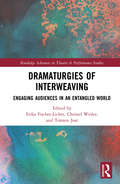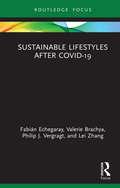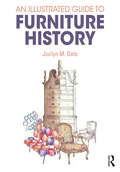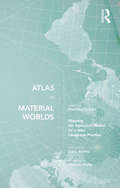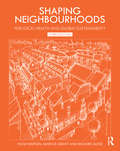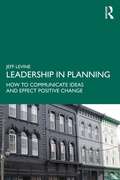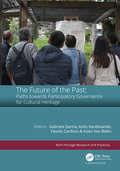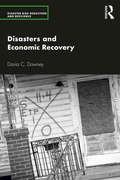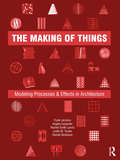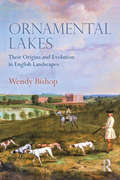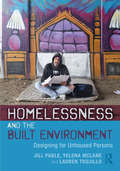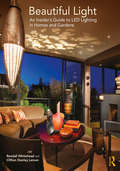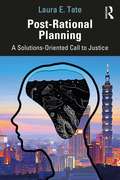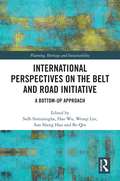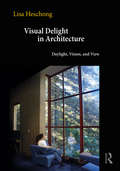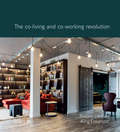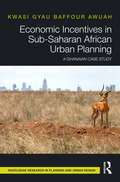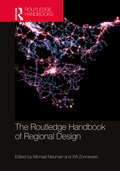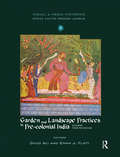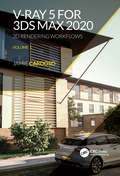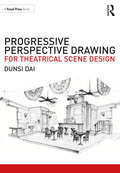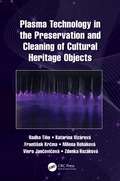- Table View
- List View
Conservation and Restoration of Built Heritage: A History of Conservation Culture and its More Recent Developments (Built Heritage and Geotechnics)
by Salvatore D'AgostinoThe word conservation, when used in the context of the preservation of built heritage, implies an intrinsically complex concept that evolved over time, since it has been influenced by the perception of history throughout time. This volume emphasises why an understanding of the cultural evolution of the conservation approach must be considered a prerequisite for architects and engineers if they are to cooperate in full harmony with historic-artistic culture for the preservation of global built heritage. In particular, the volume highlights how, during the second half of the last century, the preservation process also involved engineering – the science of making practical applications of knowledge – which, for a long time, made an uncritical use of techniques and materials and devised interventions on historical heritage that were heavily invasive. The volume also devotes special attention to the problems related to seismic risk, to which Italy, Greece and Portugal are particularly prone. Problems that emerge during the crisis and reconstruction phases are dealt with in detail, as is scheduled maintenance, as this latter approach always constitutes an improvement in the performance of the monument and is the most appropriate tool for the conservation of the built heritage. Finally, the volume collects examples of building restoration with case studies of many outstanding monuments. The work will appeal to professionals and academics in the broader fields of civil engineering (both geotechnical and structural engineering), architecture, art history, the history of architecture, restoration and cultural heritage management. This book will: Provide a critical reading of the history of conservation; Discuss materials and techniques of ancient architecture; Cover seismic vulnerability and preservation of the historic integrity of the monument; Advocate an approach based on programmed maintenance; Feature numerous case histories, including St Mark’s Basilica in Venice and the complex restoration of the cathedral of Notre-Dame in Paris.
Mapping Urban Spaces: Designing the European City
by Lamberto Amistadi Valter Balducci Tomasz Bradecki Enrico Prandi Uwe SchröderMapping Urban Spaces focuses on medium-sized European cities and more specifically on their open spaces from psychological, sociological, and aesthetic points of view. The chapters illustrate how the characteristics that make life in medium-sized European cities pleasant and sustainable – accessibility, ease of travel, urban sustainability, social inclusiveness – can be traced back to the nature of that space. The chapters develop from a phenomenological study of space to contributions on places and landscapes in the city. Centralities and their meaning are studied, as well as the social space and its complexity. The contributions focus on history and theory as well as concrete research and mapping approaches and the resulting design applications. The case studies come from countries around Europe including Poland, Italy, Greece, Germany, and France, among others. The book will be of interest to students, scholars, and practitioners in architecture, urban planning, and landscape architecture.
The Climate Planner: Overcoming Pushback Against Local Mitigation and Adaptation Plans
by Jason KingThe Climate Planner is about overcoming the objections to climate change mitigation and adaption that urban planners face at a local level. It shows how to draft climate plans that encounter less resistance because they involve the public, stakeholders, and decisionmakers in a way that builds trust, creates consensus, and leads to implementation. Although focused on the local level, this book discusses climate basics such as carbon dioxide levels in the atmosphere, the Intergovernmental Panel on Climate Change, the Paris Agreement of 2015, worldwide energy generation forecasts, and other items of global concern in order to familiarize urban planners and citizen planners with key concepts that they will need to know in order to be able to host climate conversations at the local level. The many case studies from around the United States of America show how communities have encountered pushback and bridged the implementation gap, the gap between plan and reality, thanks to a commitment to substantive public engagement. The book is written for urban planners, local activists, journalists, elected or appointed representatives, and the average citizen worried about climate breakdown and interested in working to reshape the built environment.
Dramaturgies of Interweaving: Engaging Audiences in an Entangled World (Routledge Advances in Theatre & Performance Studies)
by Erika Fischer-Lichte, Christel Weiler and Torsten JostDramaturgies of Interweaving explores present-day dramaturgies that interweave performance cultures in the fields of theater, performance, dance, and other arts. Merging strategies of audience engagement originating in different cultures, dramaturgies of interweaving are creative methods of theater and art-making that seek to address audiences across cultures, making them uniquely suitable for shaping people’s experiences of our entangled world. Presenting in-depth case studies from across the globe, spanning Australia, China, Germany, India, Iran, Japan, Singapore, Taiwan, Vietnam, the US, and the UK, this book investigates how dramaturgies of interweaving are conceived, applied, and received today. Featuring critical analyses by scholars—as well as workshop reports and artworks by renowned artists—this book examines dramaturgies of interweaving from multiple locations and perspectives, thus revealing their distinct complexities and immense potential. Ideal for scholars, students, and practitioners of theater, performance, dramaturgy, and devising, Dramaturgies of Interweaving opens up an innovative perspective on today’s breathtaking plurality of dramaturgical practices of interweaving in theater, performance, dance, and other arts, such as curation and landscape design.
Sustainable Lifestyles after Covid-19 (Routledge-SCORAI Studies in Sustainable Consumption)
by Fabián Echegaray Valerie Brachya Philip J. Vergragt Lei ZhangThis book takes an in-depth look at Covid-19-generated societal trends and develops scenarios for possible future directions of urban lifestyles. Drawing on examples from Brazil, China, and Israel, and with a particular focus on cities, this book explores the short and long-term changes in individual consumers and citizen behavior as a result of the Covid-19 pandemic. On the basis of extensive market and opinion research data, aggregate data, observational evidence, and news reports, the authors provide a detailed account of the transformations that have occurred as a result of a triple shock of public health emergency, economic shutdown, and social isolation. They also examine which of these behavioral changes are likely to become permanent and consider whether this may ultimately promote or restrain sustainable lifestyle choices. Innovative and timely, this book will be of great interest to students, scholars, and professionals researching and working in the areas of sustainable consumption, urban and land use planning, and public health.
An Illustrated Guide to Furniture History
by Joclyn M. OatsAn Illustrated Guide to Furniture History provides upper-level students and instructors with an alternative visual analytical approach to learning about furniture history from Antiquity to Postmodernism. Following an immersive teaching model, it presents a Nine-Step Methodology to help students strengthen their visual literacy and quickly acquire subject area knowledge. Moving chronologically through key periods in furniture history and interior design, such as the Renaissance, the Arts and Crafts Movement, and Modernism, it traverses Europe to America to present a comprehensive foundational guide to the history of furniture design. Part I addresses furniture within the context of the built environment, with chapters exploring the historical perspective, construction principles, and the categorization of furniture. In Part II, the author visually depicts the structural organization of the methodological process, a three-category framework: History, Aesthetics, and Visual Notes. The chapters in this part prepare the reader for the visual analysis that will occur in the final section of the book. The book is lavishly illustrated in full color with over 300 images to reinforce visual learning and notation. A must-have reference and study guide for students in industrial and product design, interior design, and architecture.
Atlas of Material Worlds: Mapping the Agency of Matter for a New Landscape Practice
by Matthew SeibertAtlas of Material Worlds is a highly designed narrative atlas illustrating the agency of nonliving materials with unique, ubiquitous, and often hidden influence on our daily lives. Employing new materialism as a jumping-off point, it examines the increasingly blurry lines between the organic and inorganic, engaging the following questions: What roles do nonliving materials play? Might a closer examination of those roles reveal an undeniable agency we have long overlooked or disregarded? If so, does this material agency change our understanding of the social structures, ecologies, economies, cosmologies, technologies, and landscapes that surround us? And, perhaps most importantly, why does material agency matter? This is the story of the world’s driest nonpolar desert, pink flamingos, and cerulean blue lithium ponds; industrial shipping logistics, pudding-like jiggling substrates, and monuments of mud; galactic bodies, radioactive sheep, and the yellowcake of uranium. Put simply, this book dares readers to see the world anew, from material up. Atlas of Material Worlds offers this new relationship to our host environment in a time of mounting crises—accelerating climate change, ballooning socioeconomic inequality, and rising toxic nationalism—uniquely telling materialist stories for practitioners and students in landscape, architecture, and other built environment disciplines.
Shaping Neighbourhoods: For Local Health and Global Sustainability
by Hugh Barton Marcus Grant Richard GuiseShaping Neighbourhoods is unique in combining all aspects of the spatial planning of neighbourhoods and towns whilst emphasising positive outcomes for people’s health and global sustainability. This new edition retains the combination of radicalism, evidence-based advice and pragmatism that made earlier editions so popular. This updated edition strengthens guidance in relation to climate change and biodiversity, tackling crises of population health that are pushing up health-care budgets, but have elements of their origins in poor place spatial planning – such as isolation, lack of everyday physical activity, and respiratory problems. It is underpinned by new research into how people use their localities, and the best way to achieve inclusive, healthy, low-carbon settlements. The guide can assist with: • Understanding the principles for planning healthy and sustainable neighbourhoods and towns • Planning collaborative and inclusive processes for multi-sectoral working • Developing know-how and skills in matching local need with urban form • Discovering new ways to integrate development with natural systems • Designing places with character and recognising good urban form Whether you are a student faced with a local planning project; a public health professional, planner, urban designer or developer involved in new development or regeneration; a council concerned with promoting healthy and sustainable environments; or a community group wanting to improve your neighbourhood – you will find help here.
Leadership in Planning: How to Communicate Ideas and Effect Positive Change
by Jeff LevineBeing an effective city planner means being an effective leader. You need to be prepared to convince people that good planning matters. Often a well-written, thoughtful and inclusive plan doesn’t result in meaningful action, because planners don’t show leadership skills. At some point, some city planners become cynical and worn down, wondering why no one listens to them but not doing the self-reflection about how that could change. Leadership in Planning explains how to get support for planning initiatives so they don’t just fade from memory. It will guide city planners to think less about organizational charts and more about: · being a respected voice within your organization, both with staff and with your boss; · being a good communicator with people outside your organization; and · being able to understand how and when to push for good planning ideas to turn them into actions. Along the way, case studies bring these concepts to the real world of municipal planning. In addition, past planning figures’ actions are explored to see what they did right and what mistakes they made.
The Future of the Past: Paths towards Participatory Governance for Cultural Heritage
by Gabriela GarcíaThe Future of the Past is a biennial conference generally carried out during the commemoration date of the incorporation of Santa Ana de Los Ríos de Cuenca Ecuador as a World Heritage Site (WHS). It initiated in 2014, organized by the City Preservation Management research project (CPM) of the University of Cuenca, to create a space for dialoguing among interested actors in the cultural heritage field. Since then, this space has served to exchange initiatives and to promote coordinated actions based on shared responsibility, in the local context. The third edition of this conference took place in the context of the 20th anniversary of being listed as WHS and a decade of CPM as the Southern host of the PRECOM³OS UNESCO Chair (Preventive Conservation, Maintenance and Monitoring of Monuments and Sites). For the very first time, and thanks to the collaboration with the Raymond Lemaire International Centre for Conservation of the University of Leuven (Belgium), the conference expanded its local scope. On this occasion, contributions reflected round a worldwide challenge in the cultural field: revealing the paths towards participatory governance of cultural heritage. Participatory governance is understood as institutional decision-making structures supported by shared responsibilities and rights among diverse actors.
Disasters and Economic Recovery (Disaster Risk Reduction and Resilience)
by Davia C. DowneyDisasters and Economic Recovery provides perspectives on the economic issues that emerge before, during, and after natural disasters in an international context, by assessing the economic development patterns that emerge before and after disaster. This book will provide a historical overview of emergency management policy and previous responses to disasters in each country, as well as the policy learning that occurred in each case leading up to the disasters under analysis. The book highlights four cases: New Orleans; Christchurch, New Zealand; the Japan earthquake and tsunami; and Hurricane Sandy in the Northeastern United States. The book places important focus on the specific collaborative developments unique to the rebuilding of each place’s economy post-disaster. Using time-series data, the book shows the emergence of new industries and job hiring patterns in the immediate aftermath, as well as provides a picture of the economic performance of each country in the years following each event. Looking at the economic development policies pre- and post-disaster, readers will glean important lessons on how to build resilient economies within the disaster framework, highlighting the differences in approaches to rebuilding local economies in places with varying levels of governmental capacity post-disaster to inform policymakers, scholars, and the disaster relief community as they plan their response to future disasters.
The Making of Things: Modeling Processes and Effects in Architecture
by Frank Jacobus Angela Carpenter Rachel Smith Loerts Justin M. Tucker Randal DickinsonThe Making of Things is about effect and intention in the schematic architectural model, a deep dive into the nature of architectonic form as the underlying syntax for all architectural work. By focusing on primitive geometries alongside fundamental principles of architectural thinking and making, this book enhances the reader’s capacity to intellectually and physically craft models that effectively communicate intention. With over 650 diagrams, this book acts as an expansive visual glossary that reveals the underlying structure of architectonics and acts as an encyclopedia of formal possibilities. Supporting essays in the book explore the nature of perception, abstraction, and metaphor to provide a theoretical basis of formal effects in architecture. This structure enables readers to make clear and direct connections between the things you construct and the reasons you construct them. This book is a bridge from the what to the why of form-making. It is a pedagogical notebook, a design primer that prompts discourse about the nature of objects. This is a must-have desk reference for beginning architecture and interior design students to stimulate their creative approaches and gain foundational knowledge of the underlying effects of formal typologies and how they manifest themselves in built forms around the world.
Ornamental Lakes: Their Origins and Evolution in English Landscapes
by Wendy BishopOrnamental Lakes traces the history of lakes in England, from their appearance in the early eighteenth century, through their development in the 1750s, and finally to their decline in the nineteenth century. Aside from the natural lakes in the Lake District, the bodies of water we see in England today are man-made, primarily intended to ornament the landscapes of the upper classes. Through detailed research, author Wendy Bishop argues that, contrary to accepted thinking, the development of lakes led to the dissolution of formal landscapes rather than following changes in landscape design. Providing a comprehensive overview of lakes in England, including data on who made these lakes, how, and when, it additionally covers fishponds, water gardens, cascades and reservoirs. Richly illustrated and accompanied by case studies across the region, this book offers new insights in landscape history for students, researchers and those interested in how landscapes evolve.
Homelessness and the Built Environment: Designing for Unhoused Persons
by Jill Pable Yelena McLane Lauren TrujilloHomelessness and the Built Environment provides a practical introduction to the effective physical design of homes and other facilities that assist unhoused persons in countries identified as middle- to high-income. It considers the supportive role that design can play for unhoused persons and other users and argues that the built environment is an equal partner alongside other therapies and programs for ending a person’s state of homelessness. By exploring issues, trends, and the unique potential of built environments, this book moves the needle of what is possible to assist people experiencing trauma. Examining important architectural and interior architectural design considerations in detail within emergency shelters, transitional shelters, permanent supportive housing, day centers, and multi-service complexes such as space planning choices, circulation and wayfinding, visibility, lighting, and materials and finishes, it provides readers with both curated conclusions from empirical knowledge and experienced designers’ perspectives. Homelessness and the Built Environment is an imperative and singular reference for interior designers, architects and building renovation sponsors, design researchers and students forging new discoveries, and policy makers who seek to assist communities affected by homelessness.
Beautiful Light: An Insider’s Guide to LED Lighting in Homes and Gardens
by Randall Whitehead Clifton Stanley LemonBeautiful Light by internationally acclaimed lighting designer Randall Whitehead and lighting industry expert and educator Clifton Stanley Lemon is a combination of idea book, design resource, and product guide. It explores the transition in residential lighting from incandescent light sources to LEDs, and how to apply LED lighting with great success. It begins with the fundamental characteristics of light, including color temperature, color rendering, and spectral power distribution, and how LEDs differ from older light sources. Combining innovative graphics with the enduring design principles of good lighting, the book explains how to design with light layers, light people, and balance daylight and electric light. Every room of the house, as well as exterior and garden spaces, is addressed in 33 case studies of residential lighting with LEDs, with a wide variety of lighting projects in different styles. Showcasing over 200 color photographs of dramatic interiors beautifully lit with LEDs, and clear, concise descriptions of design strategies and product specifications, Beautiful Light helps both professionals and non-professionals successfully navigate the new era of LEDs in residential lighting.
Post-Rational Planning: A Solutions-Oriented Call to Justice
by Laura E. TatePost-Rational Planning confronts today’s threats to truth, particularly after recent news events that present alternative facts and media smear campaigns, often described as post-truth politics. At the same time, it appreciates critical tensions: between rationality (prized by planners and other policy professionals) and desires for positive, socially just outcomes. Rather than abandoning quests for truth, this book provides planners, policy professionals, and students with tools for better responding to debates over truth. Post-Rational Planning examines planners’ unease with emotion and politics, advocating for more scholarship and practice capable of unpacking uses of rhetoric and framing to support or counter key planning decisions impacting social justice. This includes learning from recent works engaging with rhetoric, narrative construction, and framing in planning, while introducing other valuable concepts from disciplines like psychology, including confirmation bias; identity-protective cognition; from marketing and adult education. Each chapter sheds new light on a specific topic requiring a response through post-rational practice. It starts with recent research findings, then demonstrates them with case examples, enabling their use in classroom and practice settings. Each chapter ends by summarizing key lessons in "Take-aways for Practice," better enabling readers of all levels to synthesize and use key ideas.
International Perspectives on the Belt and Road Initiative: A Bottom-Up Approach (Planning, Heritage and Sustainability)
by Shannon Morreira Hao Wu Wenqi Lin Sun Sheng Han Bo QinInternational Perspectives on the Belt and Road Initiative investigates the most significant global‐scale international trade expansion and capital investment programme since the Second World War. This book focuses on the multi-national perspectives of the Belt and Road Initiative (BRI) in order to interrogate the Chinese government’s representation of it as a symbol of ‘peace, cooperation, development and mutual benefit.' With specific focus on the interrelationship between geopolitics, infrastructure investments and urban regional development, the book reflects on 12 countries’ experiences in depth, including those of Iran, Pakistan, Brazil, Thailand, Indonesia, Japan and Ethiopia, specificly to their economic development levels, political systems, power dynamics and socio-environmental issues. The book clarifies and contributes new knowledge on the nature of BRI concerning its relationship to globalism, neo-colonialism, the notion of developed vs developing countries and their institutions and macro-micro benefits and impacts. In doing so, the book offers a balanced account of the antagonistic geo-political narrative of socio-political conflict and the collaborative framework of real socio-economic flows and development. The book will appeal to academics, researchers and policy-makers with an interest in the BRI and its impacts on politico-economic development and urban, regional and spatial systems in the Indo-Pacific and beyond.
Visual Delight in Architecture: Daylight, Vision, and View
by Lisa HeschongVisual Delight in Architecture examines the many ways that our lives are enriched by the presence of natural daylight and window views within our buildings. It makes a compelling case that daily exposure to the rhythms of daylight is essential to our health and well-being, tied to the very genetic foundations of our physiology and cognitive function. It describes all the subtlety, beauty, and pleasures of well-daylit spaces and attractive window views, and explains how these are woven into the fabric of both our everyday sensory experience and enduring cultural perspectives. All types of environmental designers, along with anyone interested in human health and well- being, will fi nd new insights offered by Visual Delight in Architecture. The book is both accessible and provocative, full of personal stories and persuasive research, helping designers to gain a deeper understanding of the scientific basis of their designs, scientists to better grasp the real-world implications of their work, and everyone to more fully appreciate the role of windows in their lives.
All Together Now: The co-working and co-living revolution
by Naomi Cleaver Amy FrearsonCollaborative spaces have been hailed as either the solution to the 21st century’s culture of overwork and broken housing market, or as an unworkable and impractical aspiration. Designing for such spaces has its particular challenges and considerations, especially in how to deliver attractive, healthy and efficient collaborative places. A practical and inspirational design guide, this book draws on the author's own experience, as well as the work of others, offering workable and practical solutions, and showcases a huge variety of different kinds of collaborative spaces across the globe. Including detailed and illustrated case studies across the co-living, co-working typologies – both new build and conversion, at different scales and in different settings – it concludes with a best practice toolkit, giving practical advice and lessons for all designers working at any scale. Case studies include: *The Project, Hoxton, London *Outpost, Bali *Venn, Tel Aviv
Economic Incentives in Sub-Saharan African Urban Planning: A Ghanaian Case Study
by Kwasi Gyau Baffour AwuahThis book explores incentives capable of enhancing the effectiveness of urban planning systems in Sub-Saharan Africa using economic theory as a framework. It argues that urban planning is fundamental to the achievement of sustainable and resilient cities, but against the backdrop of rising levels of urbanisation and growth, poverty, informal development, and climate change, such systems are failing to be promoted and successfully maintained in the region. Across ten chapters, it analyses the connection between urban planning and socio-economic development, indicators of effective urban planning systems, and the role and influence of incentives with real-world evidence. It develops quantitative models to estimate the costs and benefits of urban planning systems, focussing on the developing world where organised data is less accessible. Using Ghana as a case study, it demonstrates a step-by-step approach on how to implement the quantitative models discussed. Economic Incentives in Sub-Saharan African Urban Planning will be useful reading for researchers, policy-makers, development agencies, and students in urban planning, sustainable development, and economics.
The Routledge Handbook of Regional Design
by Michael NeumanThe Routledge Handbook of Regional Design explores contemporary research, policy, and practice that highlight critical aspects of strategy-making, planning, and designing for contemporary regions—including city regions, bioregions, delta regions, and their hybrids. As accelerating urbanization and globalization combine with other forces such as the demand for increasing returns on investment capital, migration, and innovation, they yield cities that are expanding over ever-larger territories. Moreover, these polycentric city regions themselves are agglomerating with one another to create new territorial mega-regions. The processes that beget these novel regional forms produce numerous and significant effects, positive and negative, that call for new modes of design and management so that the urban places and the lives and well-being of their inhabitants and businesses thrive sustainably into the future. With international case studies from leading scholars and practitioners, this book is an important resource not just for students, researchers, and practitioners of urban planning, but also policy makers, developers, architects, engineers, and anyone interested in the broader issues of urbanism.
Garden and Landscape Practices in Pre-colonial India: Histories from the Deccan (Visual and Media Histories)
by Daud Ali; Emma J. FlattThis book presents a set of new and innovative essays on landscape and garden culture in precolonial India, with a special focus on the Deccan. Most research to date has concentrated on the comparatively well preserved gardens and built landscapes of the celebrated Mughal empire, giving the impression that they have been lacking in other times and regions. Not only does this volume provide a corrective to such assumptions, it also moves away from traditional art-historical approaches by posing new questions and exploring hitherto neglected source materials. The contributors understand gardens in two related ways: first as real or imagined spaces and manipulated landscapes that are often invested with pronounced semiotic density; and second as congeries of institutions and practices with far-reaching social ramifications for the constitution of elite societies. The essays here present a multi-disciplinary approach to the study of garden culture in precolonial India, and together suggest several new and exciting directions of enquiry for those working in the Deccan, Mughal India, and beyond.
V-Ray 5 for 3ds Max 2020: 3D Rendering Workflows Volume 1 (3D Photorealistic Rendering)
by Jamie CardosoIncrease the photorealism of your 3d visualizations with enhanced toolsets of V-Ray 5 for 3ds Max 2020. The book is filled with colorful illustrations depicting step-by-step tutorials about the process of creating a photorealistic day-and-night exterior scene. Each tutorial includes a 3d project scene to guide users through the production and the post-production processes. The book begins with an overview of the best techniques to approach clients via emails, calls, meetings, and via social media. There are also key insights into the best practices of handling projects, pricing, contracts, invoices, the pre-production, production, and the post-production, to name but a few. Throughout the book, users are taken through VRayMtl functions such as Diffuse, Roughness, Reflect, Glossiness, Metalness, Refract, Index of Refraction (IOR), Abbe number, Fog color, Translucency, BRDF, Coat, Sheen, and Bump. Also, users will learn how to use procedural maps such as VRayBitmap, VRayTriplanarTex, Bricks, Metals, Carpaint, VRayDisplacementMod, VRayUVWRandomizer, VRayMultiSubTex, VRayPointCloudColor, VRayDirt, VRayAerialPersepective, VRayLightMtl, VRayMtlWrapper, VRayOverrideMtl, VRay2SidedMtl, VRayBlendMtl, and VRayEdgesTex. In addition, there are tips and tricks accompanied with videos highlighting how to create VR interactive apps using Verge 3d; how to create verified views; and how to use plug-ins and scripts such as Project Manager, Auto grid pivot point, GarageFarm, Zmapping, gobotree, and VIShopper. Finally, users will have a rare insight into all functionalities of a VRay camera, VRayLight objects, Render settings, Frame buffer, Global switches, IPR options, Bucket and Progressive image samplers, Image filters, Global DMC, Color mapping, Brute force global illumination, Light cache, Color management, Distributed rendering, Render elements, VRay image file format, VFB History settings, VFB Lens Effects, LightMix, Film tonemap, Hue/Saturation, Lookup Table, and much more. Key Features This book deals with real projects/3d scenes and delivers up-to-date V-Ray 5 functionalities and production workflows using 3ds Max 2020 This book has professional supporting files ready to open and explore This book details the meticulous step-by-step processes of creating jaw-dropping 3d renderings This book includes unrivaled in-depth coverage of V-Ray 5 for 3ds Max 2020 This book includes 3d rendering methodologies currently used by key industry players Author Jamie Cardoso is a renowned author, reviewer, computer artist, and technologist, with years of experience in creating state-of-the-art 3d photomontages, verified views, VR, AR, XR, MR, Stereos, and photorealistic interior and exterior visualizations for architects and designers.
Progressive Perspective Drawing for Theatrical Scene Design
by Dunsi DaiProgressive Perspective Drawing for Theatrical Scene Design provides theatrical scenic designers with the tools to create quick and precise perspective drawings. The book explores three methods of perspective drawings at progressive skill levels – the Grid Method, the Frame Method, and the Freehand with References Method – allowing scenic designers to build on their drawing technique consistently. Replete with discussions on pencil techniques, step by step instructions, and set sketches from professional set design projects, this volume guides readers from the basics of the cube system to the more challenging freehand drawing. Progressive Perspective Drawing for Theatrical Scene Design is an excellent resource for students of Scene Design, Stage Design, Set Design, Scenography, Stagecraft, and Design for Theatre, as well as an accessible self-study guide for those with an interest in scene design. The book includes access to downloadable pre-made perspective grids, to help readers familiarize themselves with one and two vanishing point grids.
Plasma Technology in the Preservation and Cleaning of Cultural Heritage Objects
by Radko Tiňo Katarína Vizárová František Krčma Milena Reháková Viera Jančovičová Zdenka KozákováScientists have long been looking for alternative methods for the cleaning of historical and cultural museum objects as conventional methods often fail to completely remove surface films, leaving contamination and surface residues behind. Low-temperature plasmas have recently been found to provide a new, efficient and durable approach that maintains the safety of both the materials and personnel. This book is the first to introduce the emerging use of low-temperature plasmas in the cleaning and decontamination of cultural heritage items. It provides a comprehensive exploration of the new possibilities of cleaning objects with plasma, before providing a practice guide to the individual cleaning methods and an overview of the technologies and conditions used in the different cleaning regimes. It is an ideal reference for researchers in plasma physics, in addition to professionals working in the field of historical and cultural conservation. Features: Provides a thorough overview of the cleaning potential of emerging plasma technologies in accessible language for professional restorers and conservators without a scientific background Includes the latest case studies from the field, which have not been published elsewhere yet Authored by a team of experts in the field
